What Characteristics of Urban Green Spaces and Recreational Activities Do Self-Reported Stressed Individuals Like? A Case Study of Baoji, China
Abstract
1. Introduction
- Whether perceptions of the eight sensory dimensions differ between self-reported stressed user groups of urban green space in China.
- The preferences of the self-reported stressed individuals for the eight sensory dimensions and specific recreational activities.
- Correlations between the eight sensory dimensions and recreational activities.
2. Materials and Methods
2.1. Study Area
2.2. Data Collection
2.3. Data Analysis
3. Results
3.1. The Level of Stress and Demographic Characteristics Within Self-Reported Respondents
3.2. Perceptions of the Eight Sensory Dimensions Between Self-Reported Stressed User Groups of Urban Green Space in China
3.3. The Preferences of the Self-Reported Stressed Individuals for the Eight Sensory Dimensions and Specific Recreational Activities
3.4. Correlations Between the Eight Sensory Dimensions and Recreational Activities
4. Discussion
4.1. Perceptions of the Eight Sensory Dimensions Between Self-Reported Stressed User Groups of Urban Green Space in China
4.2. The Preferences of the Self-Reported Stressed Individuals for the Eight Sensory Dimensions and Specific Recreational Activities
4.3. Correlations Between the Eight Sensory Dimensions and Recreational Activities
5. Conclusions
Author Contributions
Funding
Acknowledgments
Conflicts of Interest
References
- Kabisch, N.; Qureshi, S.; Haase, D. Human-environment interactions in urban green spaces-A systematic review of contemporary issues and prospects for future research. EIA Rev. 2015, 50, 25–34. [Google Scholar] [CrossRef]
- United Nations, Department of Economic and Social Affairs, Population Division. World Population Prospects: The 2012 Revision; UNDESA: New York, NY, USA, 2013. [Google Scholar]
- Nielsen, T.; Hansen, K. Do green areas affect health? Results from a Danish survey on the use of green areas and health indicators. Health Place 2007, 13, 839–850. [Google Scholar] [CrossRef]
- Aldwin, C.M. Stress, Coping, and Development: An Integrative Perspective, 2nd ed.; Guilford: New York, NY, USA, 2007. [Google Scholar]
- WHO (World Health Organization). The Constitution of the World Health Organization. In NWHO Chronicle; WHO: Geneva, Switzerland, 1947. [Google Scholar]
- Stigsdotter, U.K.; Grahn, P. Stressed individuals’ preferences for activities and environmental characteristics in green spaces. Urban For. Urban Green. 2011, 10, 295–304. [Google Scholar] [CrossRef]
- McEwen, B.S. Allostasis and allostatic load: Implications for neuropsychopharmacology. Neuropsychopharmacol 2000, 22, 108–124. [Google Scholar] [CrossRef]
- Annerstedt, M.; Norman, J.; Boman, M.; Maulan, S.; Grahn, P.; Währborg, P. Finding stress relief in a forest. Ecol. Bull. 2010, 53, 33–42. [Google Scholar]
- Glaser, R.; Sheridan, J.; Malarkey, W.B.; MacCallum, R.C.; Kiecolt-Glaser, J.K. Chronic stress modulates the immune response to a pneumococcal pneumonia vaccine. Psychosom. Med. 2000, 62, 804–807. [Google Scholar] [CrossRef]
- Nilsson, M.B.; Sun, H.Y.; Diao, L.X.; Tong, P.; Liu, D.; Li, L.R.; Fan, Y.H.; Poteete, A.; Lim, S.O.; Howells, K.; et al. Stress hormones promote EGFR inhibitor resistance in NSCLC: Implications for combinations with beta-blockers. Sci. Transl. Med. 2017, 9, eaao4307. [Google Scholar] [CrossRef]
- Nielsen, L.; Curtis, T.; Kristensen, T.S.; Nielsen, N.R. What characterizes persons with high levels of perceived stress in Denmark? A national representative study. Scand. J. Public Health 2008, 36, 369–379. [Google Scholar] [CrossRef] [PubMed]
- Kaplan, R.; Kaplan, S. The Experience of Nature; Cambridge University Press: Cambridge, UK, 1989. [Google Scholar]
- Ulrich, R.S.; Simons, R.F.; Losito, B.D.; Fiorito, E.; Miles, M.A.; Zelson, M. Stress recovery during exposure to natural and urban environments. J. Environ. Psychol. 1991, 11, 201–230. [Google Scholar] [CrossRef]
- Cohen, S.; Kamarck, T.; Mermelstein, R. A Global Measure of Perceived Stress. J. Health Soc. Behav. 1983, 24, 385–396. [Google Scholar] [CrossRef]
- Bowler, D.E.; Buyung-Ali, L.M.; Knight, T.M.; Pullin, A.S. A systematic review of evidence for the added benefits to health of exposure to natural environments. BMC Public Health 2010, 10, 456. [Google Scholar] [CrossRef] [PubMed]
- Annerstedt, M.; Jönsson, P.; Wallergård, M.; Johansson, G.; Karlson, B.; Grahn, P.; Hansen, A.M.; Währborg, P. Inducing physiological stress recovery with sounds of nature in a virtual reality forest—Results from a pilot study. Physiol. Behav. 2013, 118, 240–250. [Google Scholar] [CrossRef] [PubMed]
- De Vries, S.; Verheij, R.A.; Groenewegen, P.P.; Spreeuwenberg, P. Natural environments-healthy environments? An exploratory analysis of the relationship between greenspace and health. Environ. Plann. A 2003, 35, 1717–1731. [Google Scholar] [CrossRef]
- Bergeman, J.A. Evaluating the Healing Effects of Design Elements in Therapeutic Landscapes: A Case Study of Rosecrance Healing Garden. Ph.D. Thesis, University of Colorado at Denver, Denver, CO, USA, 2012. [Google Scholar]
- Van den Berg, A.E.; Maas, J.; Verheij, R.A.; Groenewegen, P.P. Green space as a buffer between stressful life events and health. Soc. Sci. Med. 2010, 70, 1203–1210. [Google Scholar] [CrossRef] [PubMed]
- Maller, C.; Townsend, M.; Leger, L.; Henderson-Wilson, C.; Pryor, A.; Prosser, L.; Moore, M. Healthy Parks, Healthy People: The Health Benefits of Contact with Nature in a Park Context-A Review of Relevant Literature; Deakin University: Burwood, Melbourne, 2008. [Google Scholar]
- Hartig, T.; Evans, G.W.; Jamner, L.D.; Davis, D.S.; Gärling, T. Tracking restoration in natural and urban field settings. J. Environ. Psychol. 2003, 23, 109–123. [Google Scholar] [CrossRef]
- Pretty, J.; Peacock, J.; Sellens, M.; Griffin, M. The mental and physical health outcomes of green exercise. Int. J. Environ. Health Res. 2005, 15, 319–337. [Google Scholar] [CrossRef] [PubMed]
- Korpela, K.; Borodulin, K.; Neuvonen, M.; Paronen, O.; Tyrväinen, L. Analyzing the mediators between nature-based outdoor recreation and emotional well-being. J. Environ. Psychol. 2014, 37, 1–7. [Google Scholar] [CrossRef]
- Tinsley, H.E.; Johnson, T.L. A preliminary taxonomy of leisure activities. J. Leis. Res. 1984, 16, 234–244. [Google Scholar] [CrossRef]
- Anambutr, R. Relationships between Recreational Experiences and Behavioral Settings in Metroparks. Ph.D. Thesis, The University of Michigan, Ann Arbor, MI, USA, 1989. [Google Scholar]
- WHO. Promoting Physical Activity and Active Living in Urban Environments. The Role of Local Governments; Edwards, P., Tsouros, A., Eds.; WHO Regional Office for Europe: Copenhagen, Denmark, 2006. [Google Scholar]
- Grahn, P.; Stigsdotter, U.K. The relation between perceived sensory dimensions of urban green space and stress restoration. Landsc. Urban Plan. 2010, 94, 264–275. [Google Scholar] [CrossRef]
- Grahn, P.; Stigsdotter, U.A. Landscape planning and stress. Urban For. Urban Green. 2003, 2, 1–18. [Google Scholar] [CrossRef]
- Peschardt, K.K.; Stigsdotter, U.K. Associations between park characteristics and perceived restorativeness of small public urban green spaces. Landsc. Urban Plan. 2013, 112, 26–39. [Google Scholar] [CrossRef]
- Memari, S.; Pazhouhanfar, M.; Nourtaghani, A. Relationship between perceived sensory dimensions and stress restoration in care settings. Urban For. Urban Green. 2017, 26, 104–113. [Google Scholar] [CrossRef]
- Lottrup, L.; Stigsdotter, U.K.; Meilby, H.; Corazon, S.S. Associations between use, activities and characteristics of the outdoor environment at workplaces. Urban For. Urban Green. 2012, 11, 159–168. [Google Scholar] [CrossRef]
- Huang, G.R. Research the Relationship of Citizens’ Recreational Activities Types, Experience with Greenway Space. Master’s Thesis, Beijing Forestry University, Beijing, China, 2013. [Google Scholar]
- Morrison, D.F. Multivariate Statistical Methods, 2nd ed.; McGraw-Hill: New York, NY, USA, 1976. [Google Scholar]
- Manly, B.F.J. Multivariate Statistical Methods, a Primer, 2nd ed.; Chapman & Hall: London, UK, 1994. [Google Scholar]
- Chen, H.; Qiu, L.; Gao, T. Application of the eight perceived sensory dimensions as a tool for urban green space assessment and planning in China. Urban For. Urban Green. 2018. [Google Scholar] [CrossRef]
- Sang, Å.O.; Knez, I.; Gunnarsson, B.; Hedblom, M. The effects of naturalness, gender, and age on how urban green space is perceived and used. Urban For. Urban Green. 2016, 18, 268–276. [Google Scholar] [CrossRef]
- Wilkie, S.; Stavridou, A. Influence of environmental preference and environment type congruence on judgments of restoration potential. Urban For. Urban Green. 2013, 12, 163–170. [Google Scholar] [CrossRef]
- Shan, X.Z.; Yu, X.J. Citizen assessment as policy tool of urban public services: Empirical evidence from assessments of urban green spaces in China. Sustainability 2014, 6, 7833–7849. [Google Scholar] [CrossRef]
- Tong, Z.Y.; Ding, W.W. A method for planning mandatory green in China. Comput. Environ. Urban 2011, 35, 378–387. [Google Scholar] [CrossRef]
- Van Herzele, A. ‘A Tree on Your Doorstep, a Forest in Your Mind’: Greenspace Planning at the Interplay Between Discourse, Physical Conditions, and Practice; Wageningen University: Wageningen, The Netherlands, 2005. [Google Scholar]
- Jensen, F.S. Friluftsliv i det Åbne Land 1994/95 (Outdoor Recreation in the Public Landscape 1994/95); Research Report 25. Forest & Landscape; The Royal Veterinary and Agricultural University: Hørsholm, Denmark, 1998; (In Danish: English summary). [Google Scholar]
- Hartig, T.; Kaiser, F.G.; Bowler, P.A. Further Development of a Measure of Perceived Environmental Restoratives (Report No. 5); Institute for Housing Research, Uppsala University: Gävle, Sweden, 1997. [Google Scholar]
- McGinlay, J.; Parsons, D.J.; Morris, J.; Grave, A.; Hubatova, M.; Bradbury, R.B.; Bullock, J.M. Leisure activities and social factors influence the generation of cultural ecosystem service benefits. Ecosyst. Serv. 2018, 31, 468–480. [Google Scholar] [CrossRef]
- Coldwell, D.F.; Evans, K.L. Contrasting effects of visiting urban green-space and the countryside on biodiversity knowledge and conservation support. PLoS ONE 2017, 12, e0174376. [Google Scholar] [CrossRef]
- Stafford, M.; Cummins, S.; Macintyre, S.; Ellaway, A.; Marmot, M. Gender differences in the associations between health and neighbourhood environment. Soc. Sci. Med. 2005, 60, 1681–1692. [Google Scholar] [CrossRef]
- Song, C.; Ikei, H.; Kobayashi, M.; Miura, T.; Li, Q.; Kagawa, T.; Kumeda, S.; Imai, M.; Miyazaki, Y. Effects of viewing forest landscape on middle-aged hypertensive men. Urban For. Urban Green. 2017, 21, 247–252. [Google Scholar] [CrossRef]
- Abraham, A.; Sommerhalder, K.; Abel, T. Landscape and well-being: A scoping study on the health-promoting impact of outdoor environments. Int. J. Public Health 2010, 55, 59–69. [Google Scholar] [CrossRef]
- Sandifer, P.A.; Sutton-Grier, A.E.; Ward, B.P. Exploring connections among nature, biodiversity, ecosystem services, and human health and well-being: Opportunities to enhance health and biodiversity conservation. Ecosyst. Serv. 2015, 12, 1–15. [Google Scholar] [CrossRef]
- Qiu, L.; Nielsen, A.B. Are perceived sensory dimensions a reliable tool for urban green space assessment and planning? Landsc. Res. 2015, 40, 834–854. [Google Scholar] [CrossRef]
- Wilson, E.O. Biophilia; Harvard University Press: Cambridge, MA, USA, 1984. [Google Scholar]
- Wilson, E.O. The Diversity of Life; W.W. Norton: New York, NY, USA, 1999. [Google Scholar]
- Währborg, P. Stress och den nya ohälsan (Stress and the New Ill-Health); Natur och Kultur: Stockholm, Sweden, 2002. (In Swedish) [Google Scholar]
- Searles, H.F. The Nonhuman Environment in Normal Development and in Schizophrenia; International Universities: New York, NY, USA, 1960. [Google Scholar]
- Carrus, G.; Scopelliti, M.; Lafortezza, R.; Colangelo, G.; Ferrini, F.; Salbitano, F.; Agrimi, M.; Portoghesi, L.; Semenzato, P.; Sanesi, G. Go greener, feel better? The positive effects of biodiversity on the well-being of individuals visiting urban and peri-urban green areas. Landsc. Urban Plan. 2015, 134, 221–228. [Google Scholar] [CrossRef]
- Durand, C.P.; Andalib, M.; Dunton, G.F.; Wolch, J.; Pentz, M.A. A systematic review of built environment factors related to physical activity and obesity risk: Implications for smart growth urban planning. Obes. Rev. 2011, 12, e173–e182. [Google Scholar] [CrossRef] [PubMed]
- Lackey, K.J.; Kaczynski, A.T. Correspondence of perceived vs. objective proximity to parks and their relationship to park-based physical activity. Int. J. Behav. Nutr. Phys. Act. 2009, 6, 53. [Google Scholar] [CrossRef]
- Lindholst, A.C.; Dempsey, N.; Burton, M. Introducing a method for mapping recreational experience. Proc. Inst. Civ. Eng. Urban Des. Plan. 2013, 166, 296–308. [Google Scholar] [CrossRef]
- Xu, M.Y.; Xin, J.; Su, S.L.; Weng, M.; Cai, Z.L. Social inequalities of park accessibility in Shenzhen, China: The role of park quality, transport modes, and hierarchical socioeconomic characteristics. J. Transp. Geogr. 2017, 62, 38–50. [Google Scholar] [CrossRef]
- Su, S.L.; Zhang, Q.W.; Pi, J.H.; Wan, C.; Weng, M. Public health in linkage to land use: Theoretical framework, empirical evidence, and critical implications for reconnecting health promotion to land use policy. Land Use Policy 2016, 57, 605–618. [Google Scholar] [CrossRef]
- Su, S.L.; Zhou, H.; Xu, M.Y.; Ru, H.; Wang, W.; Weng, M. Auditing street walkability and associated social inequalities for planning implications. J. Transp. Geogr. 2019, 74, 62–76. [Google Scholar] [CrossRef]
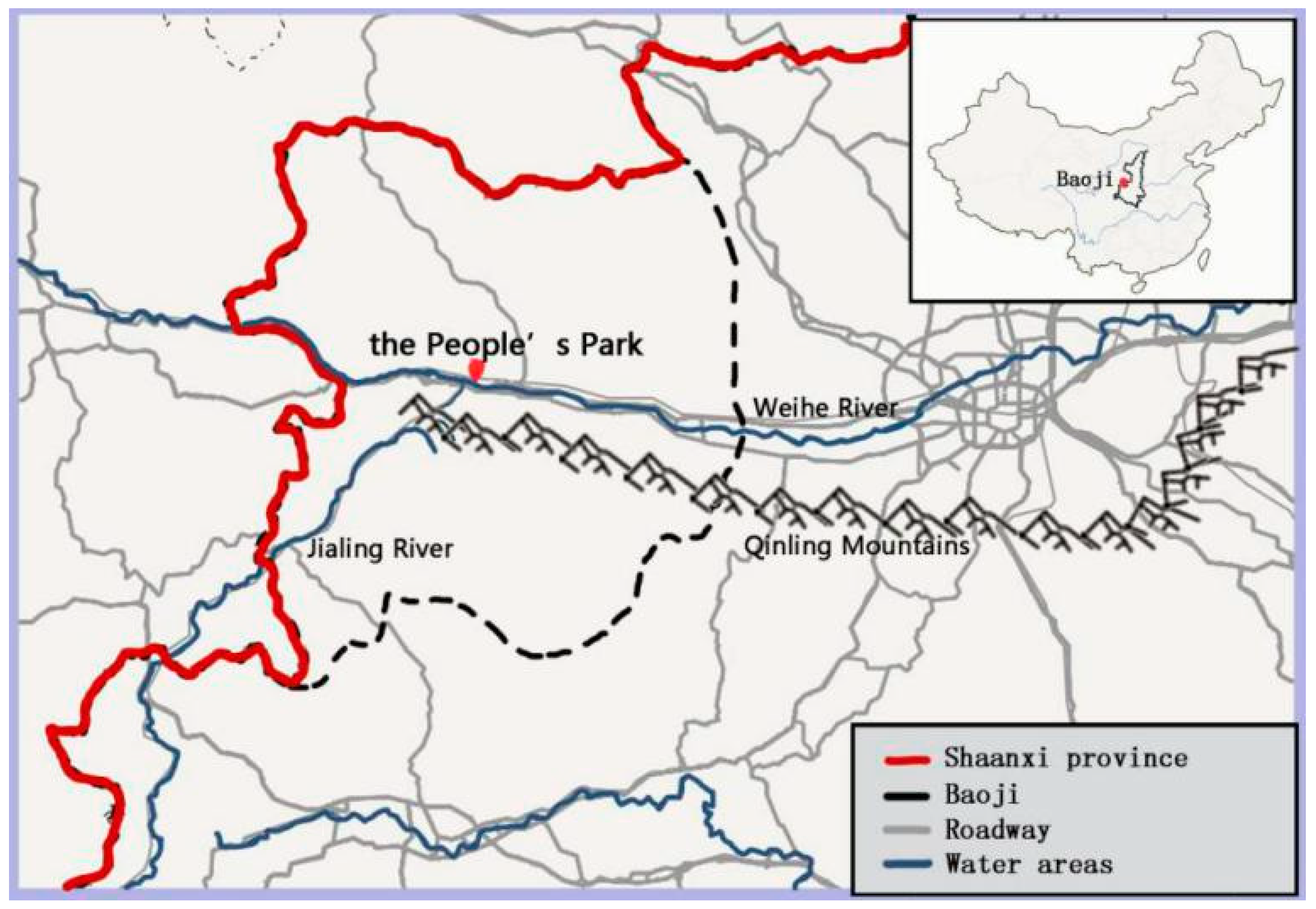
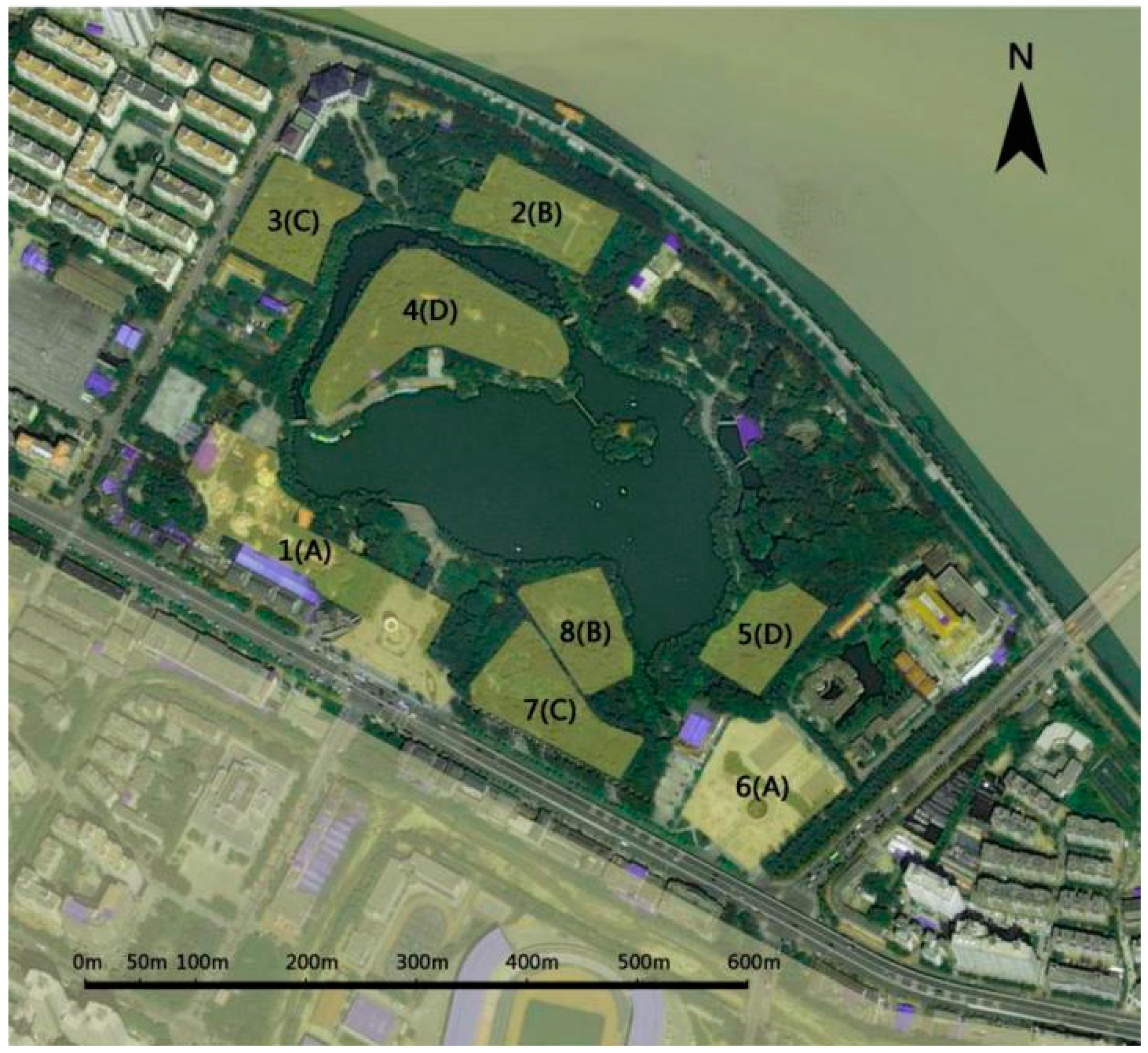
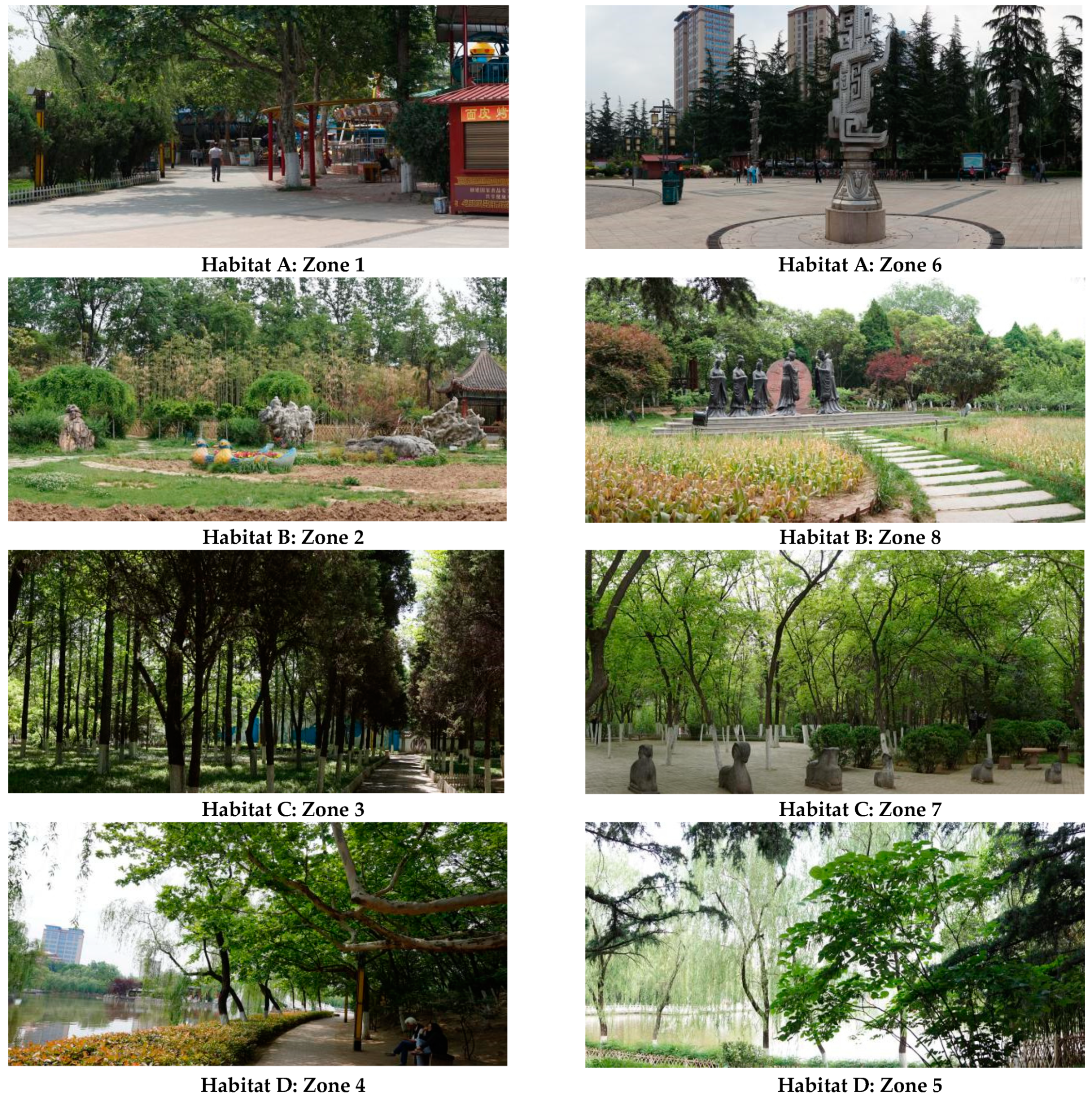
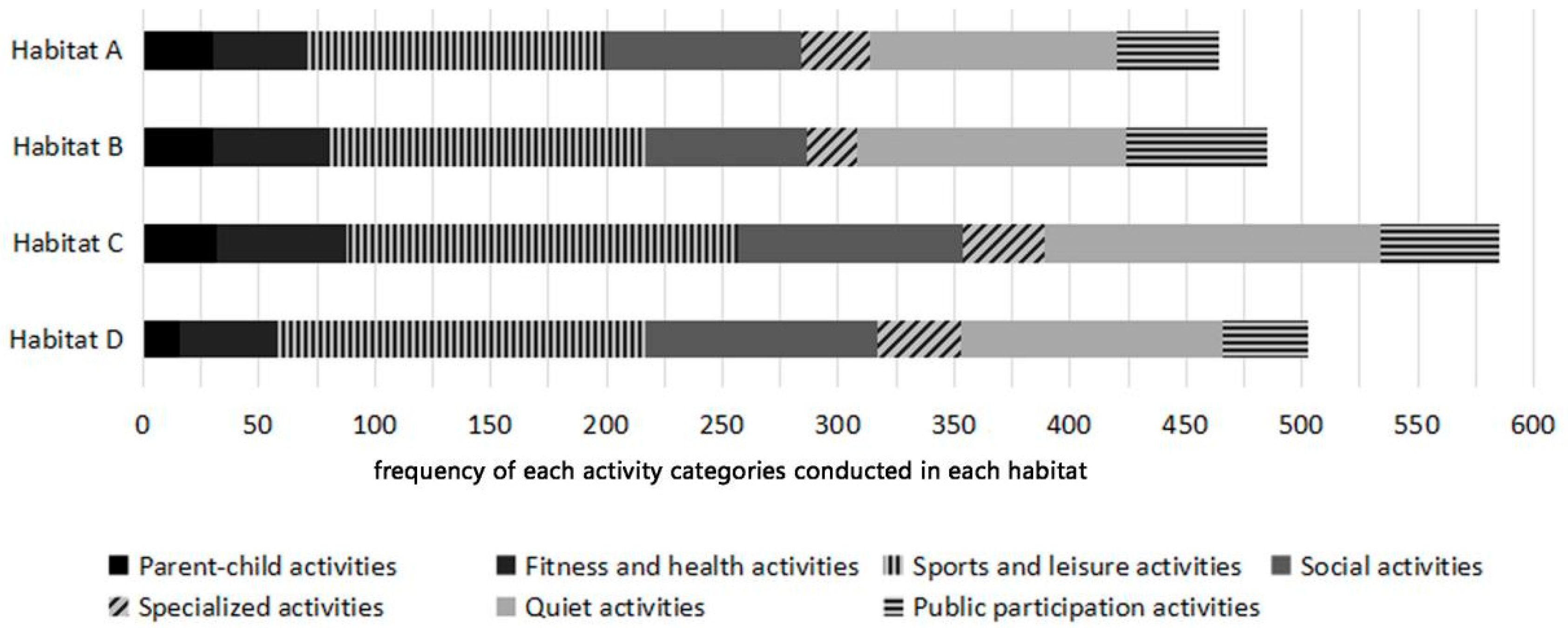
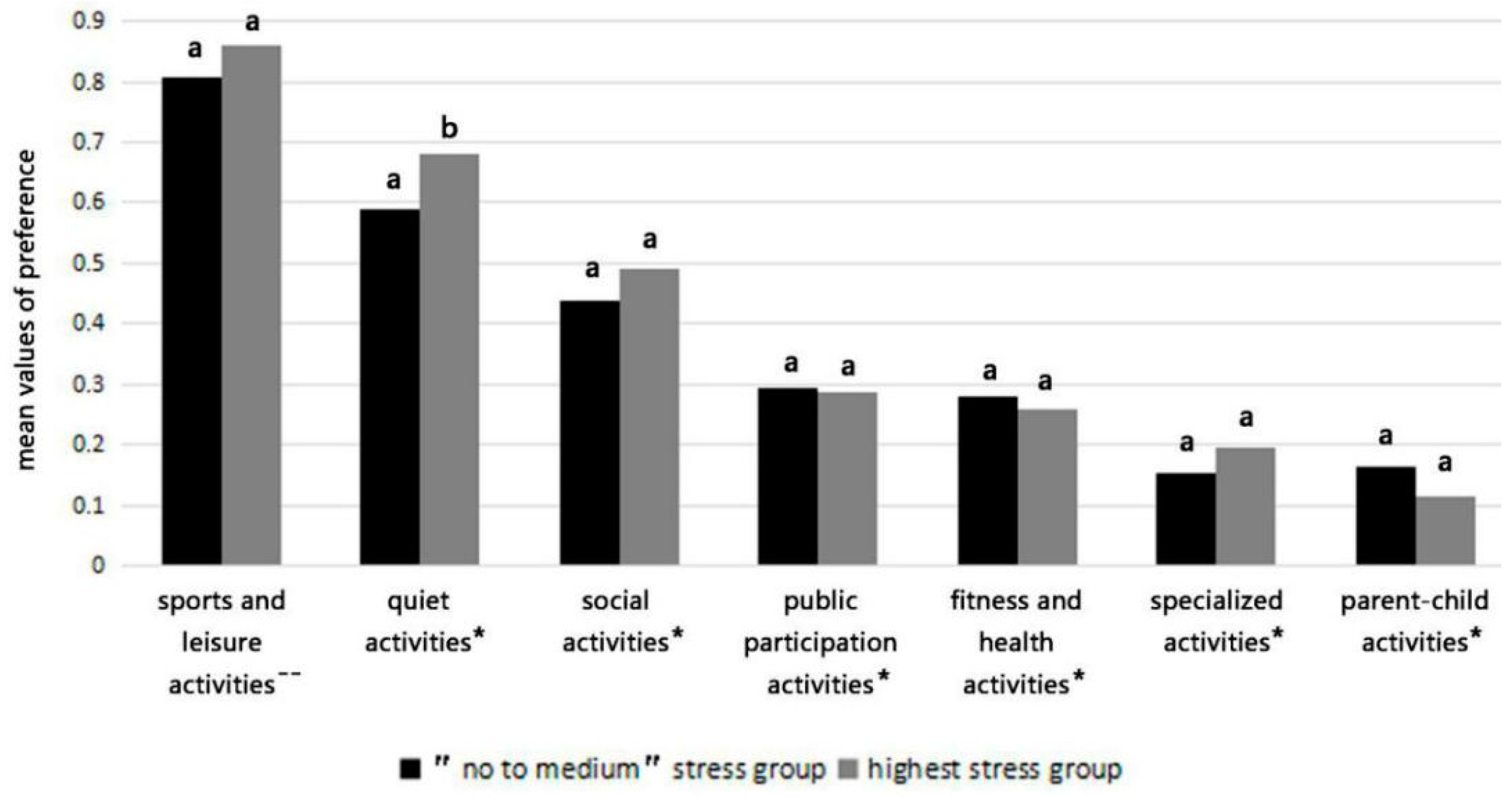
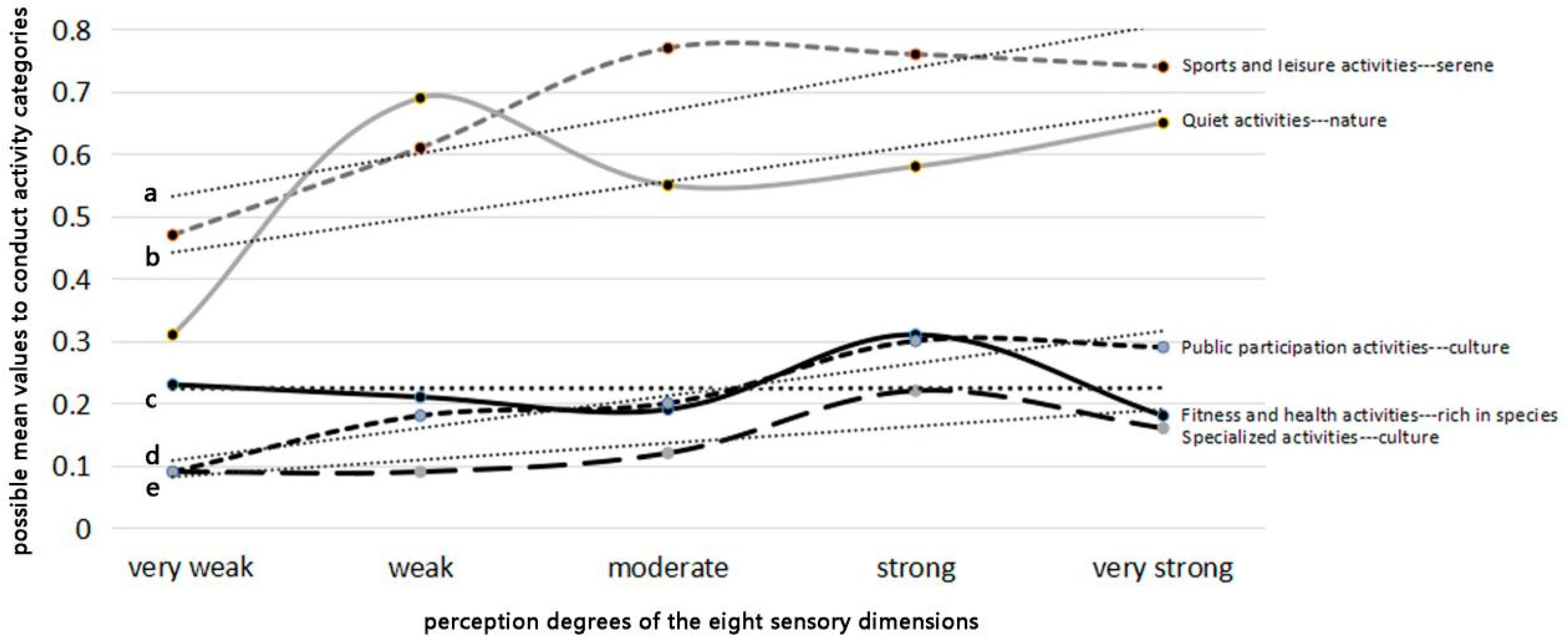
| Habitat A | Habitat B | Habitat C | Habitat D | Sum | Percentage | |
|---|---|---|---|---|---|---|
| Gender | ||||||
| Men | 83 | 148 | 140 | 102 | 473 | 57.2% |
| Women | 83 | 83 | 84 | 104 | 354 | 42.8% |
| Age | ||||||
| <13 | 2 | 3 | 9 | 2 | 16 | 1.9% |
| 13–17 | 16 | 19 | 9 | 22 | 66 | 8.0% |
| 18–25 | 61 | 42 | 50 | 98 | 251 | 30.4% |
| 26–40 | 37 | 41 | 48 | 32 | 158 | 19.1% |
| 41–60 | 28 | 57 | 59 | 32 | 176 | 21.3% |
| >60 | 22 | 69 | 49 | 20 | 160 | 19.3% |
| Sum | 166 | 231 | 224 | 206 | 827 | 100.0% |
| Habitat | Serene | Nature | Rich in species | Space | ||||
| MD1 | 95% C.I. | MD1 | 95% C.I. | MD1 | 95% C.I. | MD1 | 95% C.I. | |
| A | 0.22 | −0.25–0.69 | 0.23 | −0.22–0.67 | 0.28 | −0.16–0.73 | −0.19 | −0.56–0.18 |
| B | −0.20 | −0.54–0.14 | 0.07 | −0.26–0.41 | −0.08 | −0.40–0.24 | −0.16 | −0.49–0.18 |
| C | 0.09 | −0.24–0.43 | −0.08 | −0.39–0.24 | −0.13 | −0.45–0.20 | 0.23 | −0.09–0.54 |
| D | −0.28 * | −0.55–−0.02 | 0.23 | −0.04–0.49 | 0.22 | −0.10–0.54 | 0.06 | −0.22–0.35 |
| Habitat | Prospect | Refuge | Social | Culture | ||||
| MD1 | 95% C.I. | MD1 | 95% C.I. | MD1 | 95% C.I. | MD1 | 95% C.I. | |
| A | −0.12 | −0.54–0.30 | 0.07 | −0.32–0.46 | 0.07 | −0.30–0.45 | −0.05 | −0.48–0.38 |
| B | −0.18 | −0.56–0.20 | 0.04 | −0.31–0.39 | −0.30 | −0.66–0.06 | −0.14 | −0.54–0.26 |
| C | −0.02 | −0.37–0.33 | 0.10 | −0.23–0.42 | 0.07 | −0.29–0.43 | −0.18 | −0.57–0.20 |
| D | 0.49 ** | 0.17–0.82 | 0.01 | −0.28–0.30 | 0.06 | −0.30–0.41 | 0.20 | −0.17–0.57 |
| Perceived Sensory Dimensions | Arithmetic Mean Values | ANOVA with Post Hoc | Rank | |||
|---|---|---|---|---|---|---|
| Mean | SD | SE Mean | Mean Difference 1 | 95% C.I. | ||
| Serene | 6.52 | 1.64 | 0.13 | Reference | — | 1 |
| Space | 5.73 | 1.80 | 0.14 | 0.79 ** | 0.37–1.21 | 2 |
| Nature | 5.43 | 2.04 | 0.16 | 1.09 ** | 0.67–1.51 | 3 |
| Prospect | 4.94 | 2.03 | 0.16 | 1.58 ** | 1.16–2.00 | 4 |
| Rich in species | 3.90 | 2.14 | 0.17 | 2.62 ** | 2.21–3.04 | 5 |
| Refuge | 3.53 | 1.75 | 0.14 | 2.99 ** | 2.57–3.41 | 6 |
| Culture | 3.32 | 1.81 | 0.14 | 3.20 ** | 2.78–3.62 | 7 |
| Social | 2.72 | 2.14 | 0.17 | 3.80 ** | 3.39–4.22 | 8 |
© 2019 by the authors. Licensee MDPI, Basel, Switzerland. This article is an open access article distributed under the terms and conditions of the Creative Commons Attribution (CC BY) license (http://creativecommons.org/licenses/by/4.0/).
Share and Cite
Gao, T.; Song, R.; Zhu, L.; Qiu, L. What Characteristics of Urban Green Spaces and Recreational Activities Do Self-Reported Stressed Individuals Like? A Case Study of Baoji, China. Int. J. Environ. Res. Public Health 2019, 16, 1348. https://doi.org/10.3390/ijerph16081348
Gao T, Song R, Zhu L, Qiu L. What Characteristics of Urban Green Spaces and Recreational Activities Do Self-Reported Stressed Individuals Like? A Case Study of Baoji, China. International Journal of Environmental Research and Public Health. 2019; 16(8):1348. https://doi.org/10.3390/ijerph16081348
Chicago/Turabian StyleGao, Tian, Rui Song, Ling Zhu, and Ling Qiu. 2019. "What Characteristics of Urban Green Spaces and Recreational Activities Do Self-Reported Stressed Individuals Like? A Case Study of Baoji, China" International Journal of Environmental Research and Public Health 16, no. 8: 1348. https://doi.org/10.3390/ijerph16081348
APA StyleGao, T., Song, R., Zhu, L., & Qiu, L. (2019). What Characteristics of Urban Green Spaces and Recreational Activities Do Self-Reported Stressed Individuals Like? A Case Study of Baoji, China. International Journal of Environmental Research and Public Health, 16(8), 1348. https://doi.org/10.3390/ijerph16081348





